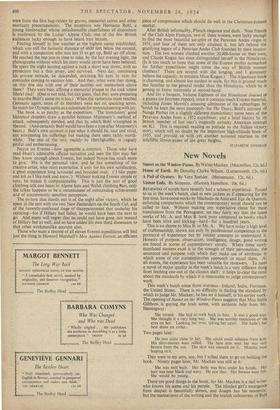High in Three Languages
Men Against Everest. By Howard Marshall. (Country Life. 9s. 6d.) Himalayan Journal, Vol. XVIII. (Oxford. 21s.) STILL they come, the high-altitude climbing books; and if, notwith- standing the sameness of the hazards described, they escape monotony and find a public far beyond climbing circles, it must be because there is nothing quite like this form of exercise for revealing the capacities of human nature—and not only the heroic ones, but the frankly odd.
The German conquest of Nanga Parbat falls into this last category. The mountain has been a killer, taking thirty-one lives, most of them German, though the first victim was our own Mummery in 1895. Dr. Herrligkoffer, organiser of the 1953 expedition, was, on his own showing, without interest in climbing as a sport. His aim was to justify and 'avenge' his stepbrother, Willy Merkl, who had had the most dreadful death of any. It is clear that the team, who were made to swear 'a sort of Olympic Oath' of discipline and devotion, were from the first hag-ridden by graves, memorial cairns and other mortuary preoccupations. The exception was Hermann Buhl, a Young Innsbrucker whose unfashionable cheerfulness of disposition is confirmed by the Ladies' Alpine Club, one of the few British audiences lucky enough to have heard him lecture.
Finding himself in fine weather at the highest camp established, which was still the fantastic distance of 4600 feet below the summit, and with a companion who was too ill to get up, Buhl set off alone. He reached the top just in time to take, by the last evening light, the photographs without which his story would never have been believed. He spent the night leaning against a rock a short way down, with no protection but a thin jersey, and survived. Next day, continuing his private miracle, he descended, straining his eyes in vain for comrades coming to succour him. And, they, what were they doing, on this fine day with one of their number out somewhere above them? They were busy affixing a memorial plaque to the rock where Merkl died! (One is not told,, but can guess, that they were preparing to inscribe Buhl's name on it too.) When the victorious team reached Germany again., most of its members were not on, speaking terms. So much for Olympic oaths as a substitute for mountaineering with joy.
The book is as patchy as the expedition. The translators' good historical chapters draw a parallel between Mummery's method of attack, subsequently derided, and that by which Buhl triumphed in the end. (And certainly Buhl would have been a type after M ummery's heart.) Buhl's own account is just what it should be, taut and vivid, not minimising his sufferings but making them seem richly. worth- while. The rest of the text, mainly by Herrligkoffer, is vaguely Pitiful and embarrassing. .
Noyce on Everest—how agreeable a contrast. Those who have read Hunt's admirable official narrative and seen the film may feel they know enough about Everest, but indeed Noyce has much more to give. His is the personal view, and he has something of the creative artist, who mbst externalise, if only for his own satisfaction, a great experience long savoured and brooded over; Cl like paper and ink as I like rock and snow.') Without making Everest simple or cosy, he makes it companionable. This is just the sort of good climbing talk one hears in Alpine huts and Welsh climbing Nhrs, only the talker happens to be a mountaineer of outstanding achievement and of uncommonly sensitive perception.
The picture that stands out is of the night after victory, which he spent in the tent with the two New Zealanders on the South Col, and of the honestly-confessed tinge of disappointment that underlay his rejoicing—for if Hillary had failed, he would have been the next to go. And, many will regret that he could not have gone, not instead of Hillary but as well, and so have added his own third dimension to that other workmanlike account also.
Those who want a resume of all eleven Everest expeditions will find just the thing in Howard Marshall's Men Against Everest, an efficient piece of compression which should do well in the Christmas-present market.
After British informality, French elegance and dash. Nine friends of the Club Alpin Francais, two of them women, were lucky enough to find the most beautiful ice-spire of the Peruvian Andes virgin in 1951, and four of them not only attained it, but left behind the gratifying legacy of a Peruvian Andes Club founded by their inspira- tion. The two women climbed another 20,000-footer on their own, and Claude Kogan has since distinguished herself in the Himalayas. (Is it too much to hope that some of the Everest profits earmarked for further expeditions might come the way of British women climbers? There are several with the longing, and I genuinely believe the capacity, to emulate Mme Kogan.) The Alpamayo book is charming, and almost too modest in scale, for this is ground much less familiar to the general reader than the Himalayas, which he is getting to know intimately at second-hand.
And for a bargain, Volume Eighteen of the Himalayan Journal at a guinea (or fourteen rupees), since it contains much Everest material, including James Morris's amusing admission of the subterfuges by 4Which he kept the news monopoly for The Times; Buhl's account of Nanga Parbat (in a slightly different translation); more news of the Peruvian Andes from a 1952 expedition; and a brief history by its British member of last year's tragically unlucky American attempt on, K2. This is required reading as prelude to the Italian victory story, which will, no doubt be the important high-altitude book of 1955, and provide us with yet another national reaction to the infallible litmus-paper of the great heights.
ELIZABETH COXHEAD











































 Previous page
Previous page